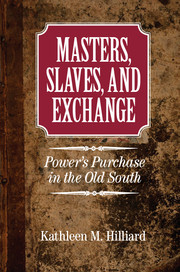3 - Servants Served
Published online by Cambridge University Press: 05 June 2014
Summary
Enslaved, for the most part, from birth until childhood, ex-slaves interviewed in the 1930s by the Works Progress Administration reveal a wide variety of experiences within the institution of Old South slavery. Tempered by both time and Jim Crow realities, the narratives vary in tone, in some cases gushing praise about “de’ old times” and, in others, venting lingering frustration about the hardships of bonded life. Children, as portrayed through the narratives, experienced both of these extremes and in later years recounted those events that had affected them most with vivid detail. For South Carolina ex-slave Gus Feaster, his first visit to the trading post was one of those experiences. According to the aged South Carolinian, “Mammy said ‘howdy’ to all de darkies what dar and I look at dem from behind her skirts. I felt real curious-like all inside ... I seed so many things dat I never had seed befo’, not in all my born days.” Although colorful bolts of cloth, barrels of sundries, and shelves of tools, trinkets, and clothing likely stood before him, one particular set of goods drew Feaster’s attention. He remarked with wonder, “Red sticks o’ candy was a laying right dar fo’ my eyes, jes’ like de folks from de big house brung us at Christmas. It was not near Christmas den ... I wondered how-come dey was having candy in de store fer, now-how.” Following the boy’s gaze, Feaster’s mother turned to the clerk, a man with a beard, and asked, “Marse, please sir, give me five cent worth peppermint candy.” Having satisfied her young son, his mother turned to the errand at hand, purchasing a bonnet for “ten dollars worth o’ cotton.”
- Type
- Chapter
- Information
- Masters, Slaves, and ExchangePower's Purchase in the Old South, pp. 69 - 93Publisher: Cambridge University PressPrint publication year: 2013

